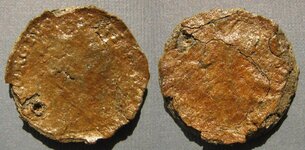Mike in Berks
Hero Member
- Jun 17, 2007
- 647
- 7
- Detector(s) used
- 4/DB Spectrum XLT DFX
i was searching a circa 1850's house yesterday found this ? 4 1/2" deep
lifted the plug and it dropped in the hole i saw it was round and 1st thought was
lead picked it up and i saw flaking around the edges and after seeing so many
counterfeit coins dug on t net i thought no, it can't be so i did a little rubbing
so i did a little rubbing
with my digging cloth did'nt see anything so i put in the coin tube
when i got home i took it out and i saw a weak liberty on the obverse and one cent
on the reverse i do think this was excavated when they had a cement patio put in
and then buried again when they were finished the whole edge is flaking
i do know she is facing left 1808 -- i need your advice people how should i clean
and preserve this relic ? i do not know if it's pewter or pot metal ? ?
i hope you can see the weak liberty - obv.

and one cent on the rev.

and a side view - flaking

thanks for looking
lifted the plug and it dropped in the hole i saw it was round and 1st thought was
lead picked it up and i saw flaking around the edges and after seeing so many
counterfeit coins dug on t net i thought no, it can't be
 so i did a little rubbing
so i did a little rubbingwith my digging cloth did'nt see anything so i put in the coin tube
when i got home i took it out and i saw a weak liberty on the obverse and one cent
on the reverse i do think this was excavated when they had a cement patio put in
and then buried again when they were finished the whole edge is flaking
i do know she is facing left 1808 -- i need your advice people how should i clean
and preserve this relic ? i do not know if it's pewter or pot metal ? ?
i hope you can see the weak liberty - obv.

and one cent on the rev.

and a side view - flaking

thanks for looking






